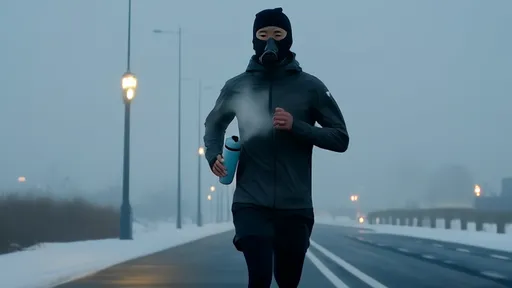The crisp winter air carries a particular invigoration that draws many runners to embrace early morning jogs. Yet beneath the allure of frost-laced landscapes and quiet streets lies an often-overlooked challenge: the delicate interplay between cold air and lung health. For those who cherish winter running, understanding how to protect the respiratory system becomes as crucial as selecting the right pair of insulated gloves.
The Physiology of Cold Air Inhalation
When temperatures plummet, the air loses its humidity, transforming into a dry, icy force that can irritate the bronchial tubes. The human respiratory tract is lined with delicate mucous membranes designed to warm and humidify incoming air. However, during intense exercise like running, the body demands more oxygen, forcing faster and deeper breaths. This rapid inhalation bypasses the nose’s natural warming mechanisms, allowing cold air to surge directly into the lungs. The result? A tightening sensation, coughing, or even exercise-induced bronchospasm—a temporary constriction of the airways that leaves runners wheezing.
Myths and Realities of Winter Breathing
Popular wisdom suggests covering the mouth with a scarf, but this well-intentioned tactic can backfire. Fabric traps moisture from exhalation, quickly becoming damp and icy, further chilling incoming air. Modern technical fabrics designed for runners offer better solutions, but even these require strategic use. Another misconception is that only asthmatics need worry about cold-weather breathing. In truth, even healthy lungs react to extreme cold; the difference lies in severity and recovery time.
The Art of Nasal Breathing in Winter
Ancient runners—from Greek messengers to Himalayan sherpas—relied on nasal breathing as natural insulation. The intricate turbinates within the nose increase surface area, allowing more time for air to warm before reaching sensitive lung tissue. While maintaining nasal-only breathing during vigorous running proves challenging, hybrid techniques exist. Inhaling through the nose while exhaling through pursed lips creates a pressure gradient that slows airflow, reducing thermal shock. This method requires practice but pays dividends in respiratory comfort during sub-zero miles.
Hydration’s Hidden Role in Respiratory Protection
Winter’s deceptive dryness leaches moisture from the body with every exhaled vapor plume. Dehydration thickens mucosal linings in the respiratory tract, impairing their ability to trap pathogens and warm incoming air. Unlike summer running where thirst provides obvious cues, cold-weather hydration demands proactive discipline. Warm herbal teas with anti-inflammatory properties—such as ginger or licorice root—serve dual purposes: maintaining internal hydration and coating the throat with protective compounds.
Strategic Warm-Ups for Lung Preparation
Elite Nordic skiers employ progressive breathing exercises before braving frozen trails. Starting with diaphragmatic breathing—deep belly breaths that engage the parasympathetic nervous system—they gradually introduce cold air in controlled increments. This "pre-cooling" technique essentially teaches the lungs to handle temperature gradients. For urban runners, spending five minutes doing breathwork indoors while donning running gear allows the body to begin thermoregulation before facing the elements.
Post-Run Respiratory Recovery
The aftermath of a winter run demands as much attention as preparation. Sudden re-entry to heated environments can trigger bronchial spasms as capillaries rapidly dilate. Savvy runners keep post-run environments slightly cool, removing damp base layers immediately to prevent conductive heat loss. Steam inhalation with eucalyptus oil helps rehydrate respiratory passages, while avoiding hot showers for at least twenty minutes allows gradual thermal readjustment.
As winter running gains global popularity, the conversation evolves beyond mere clothing layers to encompass holistic respiratory strategies. From Himalayan altitude techniques repurposed for urban frost to nanotechnology fabrics that regulate microclimates around the face, the frontier of cold-weather running science continues to expand. What remains constant is the runner’s respect for the delicate balance between endurance and the elemental forces they challenge with each morning’s determined stride.

By /Jul 28, 2025

By /Jul 28, 2025

By /Jul 28, 2025

By /Jul 28, 2025

By /Jul 28, 2025

By /Jul 28, 2025

By /Jul 28, 2025

By /Jul 28, 2025

By /Jul 28, 2025

By /Jul 28, 2025

By /Jul 28, 2025

By /Jul 28, 2025

By /Jul 28, 2025

By /Jul 28, 2025

By /Jul 28, 2025

By /Jul 28, 2025

By /Jul 28, 2025

By /Jul 28, 2025